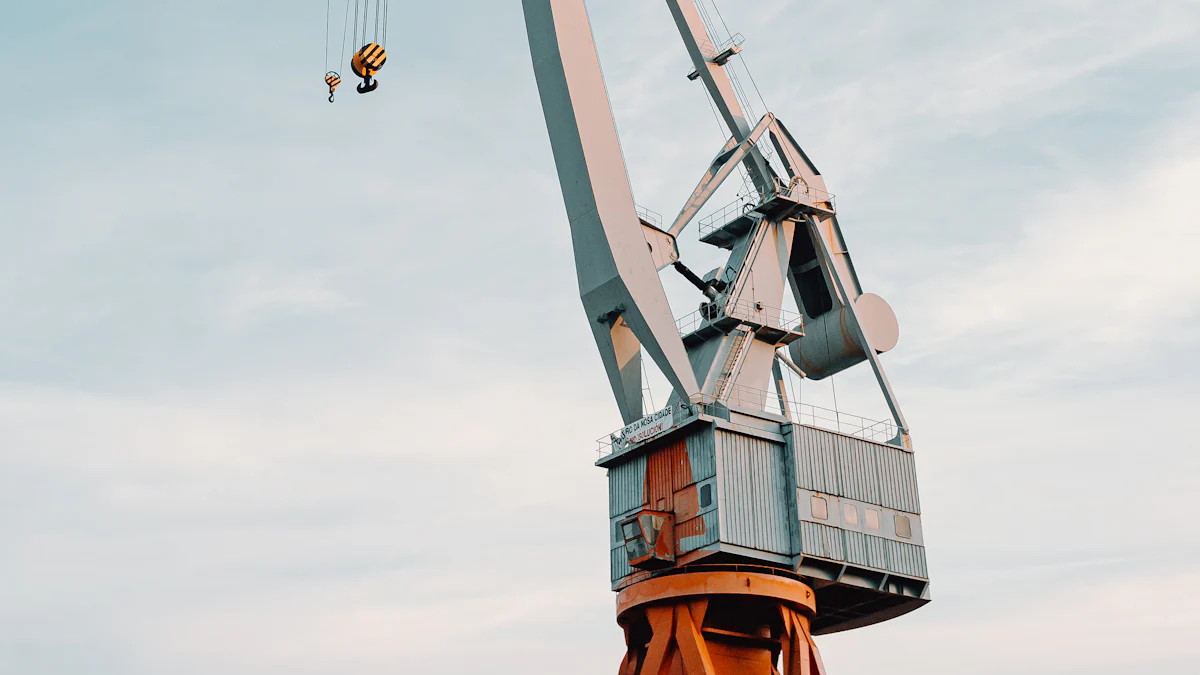How to Identify and Understand Overhead Crane Components
Date: 2024-05-14 Share:

Exploring the Basics of Overhead Cranes
Defining Overhead Cranes
Overhead cranes, also known as bridge cranes, are a type of material handling equipment used to lift, transport, and lower heavy loads within a specific area. These cranes are commonly found in warehouses, manufacturing facilities, and distribution centers, etc.. One of the basic purposes of overhead cranes is to streamline the movement, which improves the operational efficiency and minimizing manual labor. Their applications span across construction, automotive, aerospace, and logistics.
The evolution of overhead cranes has been marked by significant advancements in technology and design. Initially conceptualized in the early 20th century as a solution for lifting and transporting heavy loads with increased ease and efficiency, overhead cranes have undergone remarkable transformations over the years.
The Purpose and Applications of Overhead Cranes
According to market research reports, the global overhead cranes market size was valued at USD 5649.5 million in 2021 and is projected to grow significantly in the coming years. These statistics highlight the widespread use and growing demand for overhead cranes across different sectors.
The Evolution of Overhead Cranes
The transition from manual to automated systems has been a pivotal development in the evolution of overhead cranes. Enhanced lifting capacity through the incorporation of stronger materials like steel and optimization of structural designs has led to significant advancements in crane design. Furthermore, the introduction of steel and other advanced materials has made cranes lighter, stronger, and more durable.
Historically, Ludwig Stuckenholz produced the first overhead cranes in Germany during the 1830s which were initially run on steam. However, with the industrial revolution came a shift from steam to electricity as the dominant form of power for overhead cranes. This transition revolutionized industrial production and contributed to the growth of modern economies around the world.
What are Overhead Crane Components?
Overhead cranes consist of several essential components that work together to facilitate the lifting, movement, and control of heavy loads within industrial settings. Understanding these components is crucial for ensuring the safe and efficient operation of overhead cranes.
The Structural Elements
Girders: The Backbone of the Crane
Girders, also known as bridge beams, form the primary horizontal structure of an overhead crane. They provide support for the trolley and hoist, enabling them to traverse along the length of the crane. Girders are typically constructed from sturdy materials such as steel to withstand heavy loads and ensure structural integrity.
The Runway: Guiding the Crane’s Movement
The runway serves as a track along which the crane moves horizontally to transport loads within a specific area. It is essential for guiding the crane’s movement and ensuring precise positioning during lifting and lowering operations. Runways are designed to withstand substantial weight and offer smooth traversal for the crane.
The Lifting Mechanism
Hoists and Hooks: Facilitating the Lift
The hoist is a critical component responsible for lifting and lowering heavy loads with precision and control. It is equipped with a hook or other lifting attachments to securely hold the load during transportation. Hoists play a pivotal role in facilitating vertical movement while maintaining safety standards.
The Role of the Wire Rope or Chain
The wire rope or chain forms an integral part of the lifting mechanism, providing support and stability during load handling. These components are designed to withstand high tension forces while ensuring reliable lifting operations. Wire ropes or chains are selected based on load capacity, environmental conditions, and specific application requirements.
Power and Control Systems
Electrical Components: The Heart of Crane Operation
Overhead cranes rely on electrical components such as motors, drives, and controllers to power their movement and lifting functions. These components form the core operational system of cranes, enabling seamless control over load handling operations. Electrical components are engineered for efficiency, reliability, and precise motion control.
Control Systems: Ensuring Precision and Safety
Control systems encompass a range of technologies including pendant stations, wireless controls, or cabin-operated consoles that enable operators to manage crane movements with accuracy. These systems are designed to ensure precise positioning while prioritizing operator safety throughout operations. Control systems contribute significantly to enhancing operational efficiency while maintaining stringent safety standards.
The Role of Safety and Control Systems in Overhead Cranes
Safety and control systems are integral components of overhead cranes, playing a crucial role in ensuring the protection of personnel, equipment, and materials within industrial environments. Understanding the function and significance of these systems is essential for maintaining a safe and efficient operational environment.
Understanding Safety Systems
Preventative Measures and Emergency Stops
Overhead crane safety systems encompass a range of preventative measures designed to mitigate potential hazards and minimize the risk of accidents. These measures include the implementation of emergency stop controls that enable immediate halting of crane operations in response to unforeseen circumstances or impending dangers. Additionally, safety devices such as limit switches are installed to prevent over-travel or overloading, safeguarding against structural damage or hazardous situations.
Expert Testimony:
Assessing the functionality and safety of control systems and troubleshooting electrical issues related to crane operations.
Regular inspections and adherence to safety protocols are fundamental aspects of maintaining an effective safety system. Inspections involve comprehensive assessments of crane components, including girders, runways, hoists, wire ropes/chains, electrical systems, and control mechanisms. These inspections ensure that all elements are functioning optimally and identify any potential issues that require attention. Furthermore, safety protocols outline specific guidelines for crane operators and maintenance personnel to follow during routine operations and emergency scenarios.
The Importance of Control Systems
Control systems within overhead cranes serve as the central mechanism for managing lifting operations with precision and efficiency. They play a pivotal role in dictating the movement, positioning, and speed of the crane while prioritizing operator safety.
Manual vs. Automated Control
The choice between manual or automated control systems depends on the specific requirements of the lifting tasks at hand. Manual control allows operators to directly oversee crane movements through pendant stations or cabin-operated consoles. On the other hand, automated control systems utilize advanced technologies such as wireless controls or programmable logic controllers (PLCs) to streamline crane operations with enhanced accuracy.
Control systems contribute significantly to enhancing operational efficiency by enabling precise load positioning and movement coordination. Automated control mechanisms offer increased productivity by reducing human error while ensuring consistent performance across various lifting tasks. Moreover, these systems incorporate advanced features such as sway control technology that minimizes load oscillations during lifting operations, further enhancing overall safety standards.
Maintaining Your Overhead Crane: Tips and Best Practices
Regular maintenance is essential for ensuring the longevity and optimal performance of overhead cranes. By implementing routine checks and professional inspections, potential issues can be identified and addressed promptly, contributing to a safe and efficient operational environment.
Routine Maintenance: The Key to Longevity
Daily Checks and Periodic Inspections
To maintain the functionality of overhead cranes, it is imperative to conduct daily checks to assess their operational status. These checks involve inspecting critical components such as girders, runways, hoists, wire ropes/chains, electrical systems, and control mechanisms. Regular inspections help in identifying any signs of wear, damage, or malfunction that may compromise the crane’s performance or pose safety risks. Additionally, periodic inspections by qualified technicians are crucial for detecting underlying issues that may not be apparent during daily checks.
Identifying Common Issues Before They Escalate
Common issues that may arise in overhead cranes include misalignments in the runway structure, worn-out wire ropes/chains, electrical malfunctions, or deteriorating control systems. Identifying these issues early on is paramount to prevent them from escalating into more significant problems that could disrupt operations or lead to accidents. Early detection allows for timely intervention through appropriate maintenance or repairs, ultimately minimizing downtime and ensuring continuous productivity.
Professional Maintenance and Repairs
When to Call in the Experts
While daily checks and periodic inspections are valuable for proactive maintenance efforts, there are instances where specialized expertise is required to address complex issues or perform intricate repairs. Calling in certified technicians becomes necessary when dealing with technical malfunctions or structural concerns that demand specialized knowledge and skills. Expert technicians possess the proficiency to diagnose underlying problems accurately and execute precise repairs while adhering to industry standards.
The Importance of Certified Technicians
Certified technicians bring a wealth of experience and expertise in maintaining overhead cranes at optimal performance levels. Their comprehensive understanding of crane systems enables them to identify potential hazards and rectify mechanical faults effectively. Moreover, certified technicians adhere to stringent safety protocols while conducting maintenance tasks, prioritizing the well-being of personnel working with or around overhead cranes.
Lubrication plays a critical role in preserving the functionality of overhead cranes by reducing friction between moving parts and preventing premature weariness due to constant exposure to extreme environments. Utilizing qualified oil for lubrication ensures smooth operations while extending the lifespan of crucial components within the crane system.
By integrating these best practices into maintenance routines, operators can uphold the reliability and efficiency of overhead cranes while safeguarding against potential hazards associated with neglected upkeep.
Conclusion: Reflecting on the Importance of Understanding Overhead Crane Components
The Benefits of Knowledge
Understanding the intricacies of overhead crane components yields a multitude of benefits, ranging from heightened safety measures to empowering operational and maintenance teams.
Improved Safety and Efficiency
Comprehensive knowledge of overhead crane components is instrumental in fostering a safer work environment. By understanding the structural elements, lifting mechanisms, and power/control systems, operators can execute lifting operations with enhanced precision and precaution. This awareness contributes to mitigating potential hazards and minimizing the risk of accidents within industrial settings. Moreover, a deep understanding of safety and control systems equips personnel with the expertise to implement preventative measures effectively, ensuring that crane operations adhere to stringent safety protocols. Ultimately, this knowledge fosters an environment where safety takes precedence, promoting efficient workflow while safeguarding personnel and valuable assets.
Empowering Operators and Maintenance Teams
Empowering operators and maintenance teams with in-depth knowledge of overhead crane components instills confidence in their ability to handle complex tasks proficiently. Operators equipped with comprehensive understanding can navigate crane operations with finesse, leveraging their expertise to optimize load handling processes and streamline material transportation. Similarly, maintenance teams armed with extensive knowledge are adept at identifying underlying issues promptly, executing necessary repairs or adjustments skillfully. This empowerment not only enhances operational efficiency but also cultivates a culture of competence and proficiency within the workforce.
In conclusion, the significance of comprehending overhead crane components cannot be overstated. It serves as the cornerstone for fostering a secure operational environment while empowering personnel to execute tasks with precision and expertise.
By embracing this knowledge, industries can elevate their operational standards, prioritize safety measures, and maximize the efficiency of overhead crane systems.
Nante Crane
Nante Crane is a leading manufacturer of overhead crane components, providing a comprehensive range of parts that are essential for the operation and maintenance of overhead cranes. These components are designed with the highest standards of quality, safety, and efficiency in mind.
The main components of Nante Crane’s overhead cranes include the bridge, which is the horizontal structure that carries the load; the hoist and trolley, which lift and move the load along the bridge; and the runway, which is the structure that supports the crane. The bridge is typically composed of two end trucks and one or two bridge girders, depending on the capacity of the crane.
The hoist and trolley are the heart of the crane, responsible for lifting and moving the load. Nante Crane offers a variety of hoists and trolleys, each designed for specific applications and load capacities. The hoist is equipped with a wire rope or chain, and a hook for attaching the load. The trolley moves along the bridge, carrying the hoist and the load.
The runway of Nante Crane’s overhead cranes is designed to support the weight of the crane and the load. It consists of two parallel rails, supported by a structure of beams and columns.
Other key components of Nante Crane’s overhead cranes include the drive mechanisms, which move the crane and trolley; the controls, which operate the crane’s movements; and the safety devices, such as limit switches and overload protectors, which prevent accidents and damage to the crane.
In conclusion, Nante Crane’s overhead crane components are designed to ensure the safe, efficient, and reliable operation of overhead cranes. Understanding these components is crucial for anyone involved in the operation, maintenance, or inspection of overhead cranes.
 English
English






